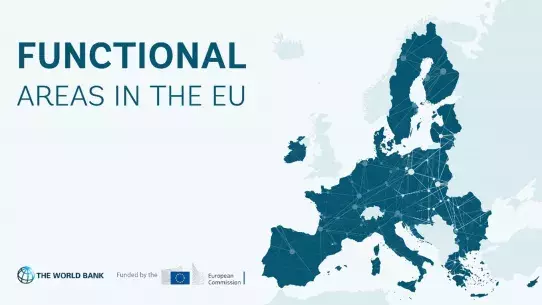Handbook of territorial & local development strategies Chapter 3 - Governance

Introduction
EU integrated territorial development strategies are implemented in a complex setting of multi-level governance. General goals and procedural rules are set at the EU level. National regional and local governments decide on how to meet these general goals. They establish specific goals that reflect their needs and potentials, provided they are consistent with the main objectives and policy architecture. They design policy interventions crafted according to the specific territorial context, together with relevant actors. Throughout policy implementation, national, regional and local authorities are expected to assess and revise goals, performance measures and decision-making procedures on the basis of emerging evidence. In addition, they must report regularly on their performance to the EU authorities and to their constituencies.[1]
In this context, two main bodies operating at a different spatial scale are particularly important.
- The managing authorities of the Operational Programmes of EU Funds. These authorities function at national or regional level and are responsible for the design and operationalisation of the policy framework within which the territorial strategies are designed and implemented. They are usually public authority bodies.
- The body (or bodies) responsible for the design and implementation of the territorial strategy. Depending on the type of territorial implementation mechanism, the body responsible for the strategy may vary. In the case of ITI strategies this role is usually played by a regional or a local authority, an association of local authorities or a dedicated body; in a CLLD, it is usually played by a local partnership, the Local Action Group (LAG), involving public and private actors.[2]
Other public entities, private organisations, associations and citizens are expected to be part of the governance arrangements. At a minimum, they should be consulted at the strategy design stage, but successful implementation of the strategy may require a stronger involvement of such actors going well beyond consultation and into participation and co-decision.
The set-up of governance structures and processes for EU integrated territorial development strategies in non-urban areas can be particularly challenging.
As discussed in Chapter 2, Territorial Focus, integrated territorial development strategies normally include several small municipalities and cross administrative boundaries. They cover functional areas connected through a variety of linkages (commuting and labour market patterns, access to services, etc.) and/or areas with specific geographical characteristics, cultural identities, etc.
There is a clear added value of EU integrated territorial development strategies at the level of functional areas.[3] For instance, in peripheral, low-density and sparsely populated areas, effective collaboration between municipalities is particularly needed for the provision of essential services such as education and health services ( EC, 2021b; OECD, 2021). Soft territorial cooperation arrangements can bring a number of potential benefits. Organisational flexibility can increase ownership and improve implementation, and membership variety in territorial development strategies makes it possible to involve different levels of government and public and private stakeholders on equal footing (ESPON, 2017).
However, territorial cooperation comes with challenges. Difficulties may emerge in identifying the territorial and thematic scope of strategies, as well as establishing sustainable coordination mechanisms (Van der Zwet et al., 2017). The involvement of different local and sub-regional authorities tend to increase coordination costs. Finally, in areas with low population density and extensive territorial coverage it can be difficult to bring actors together.
Furthermore, non-urban areas are a key target of several distinct policies at EU level. They are explicitly addressed by the rural development policy through the European Agricultural Fund for Rural Development (EAFRD) and by the EU cohesion policy. In coastal or insular areas, the European Maritime Policy is also relevant.
The boundaries between these policies are often fuzzy. They rely on similar implementation structures and mechanisms (e.g. national or regional managing authorities) and some of their thematic priorities can overlap. Yet, responsibilities are typically separate at EU, national and regional levels and the policies are implemented through parallel governance and delivery structures (Kah, Georgieva and Fonseca, 2020).
Against this background, this building block chapter focuses on the key aspects of governance, providing examples and recommendations.
The effective governance of EU integrated territorial development strategies in non-urban areas requires the capacity to coordinate within and across different levels of government, public administrations and agencies, as well as the capacity to engage with the private sector, other public entities, NGOs and citizen groups in the concerned territory. Sound governance arrangements imply that organisations responsible for the management of the strategies are empowered with political support along with organisational and analytical capacities to perform policy functions and operate closely to the local level. Channels for negotiation and collaboration with private and public actors need to be in place, together with coordination mechanisms across different spatial scales and between managing authorities, different ministries/departments and local authorities. Another key ingredient for effective governance is the availability of adequate skills and resources, in both public authorities and relevant stakeholders, to effectively carry out strategy formulation, implementation and monitoring.
Challenge 1 : How to identify suitable governance structures ?
Putting in place effective governance structures requires decisions on which bodies are responsible for the implementation of the territorial strategies at Operational Programme and strategy level and how responsibilities are shared between these two levels.
Challenge 1 : How to identify suitable governance structures ?
Learn moreChallenge 2 How to ensure coordination between actors at different governance levels ?
The governance architecture of EU integrated territorial development strategies strongly relies on the functioning of vertical (across different levels) and horizontal (among different bodies at the same level) coordination mechanisms to successfully design and implement public interventions.
Vertical coordination takes place between governance bodies and actors placed at different spatial scales. It is needed to: a) bring to the fore the different agendas and interests of all levels of government and relevant stakeholders, making sure that local needs are included in national and regional policy schemes for territorial strategies; b) ensure effective implementation and coherence across different territorial levels; and c) avoid duplications, promote synergies and reduce the administrative burden for beneficiaries. Vertical coordination is needed to set up a coherent framework with adequate mechanisms that can address different territorial needs and challenges and facilitate cross-sectoral interventions for sound integrated territorial development strategies.
In countries where operational programmes are managed at different territorial levels (e.g. ERDF operational programmes managed at regional level and a single Rural Development Programme at national level), effective vertical coordination is a key condition for setting up a clear policy framework for territorial integrated strategies.
Horizontal coordination mechanisms are expected to ensure coherence between the different policy areas, instruments and implementing authorities (ministries, Managing Authorities, departments, agencies, etc.). Effective horizontal coordination is essential to support integrated cross-sectoral policy interventions and the combination of different funding sources.
At the local level, horizontal coordination can help build permanent cooperation models to address local governments’ challenges, including lack of staff capacity, fragmented access to information on business needs and labour skills and difficulties in providing essential services. Such co-operation can be done through institutionalised inter-municipal bodies (at local or regional level) or more flexible inter-municipal agreements (OECD, 2020a ).[9]
Challenge 2 How to ensure coordination between actors at different governance levels ?
Learn moreChallenge 3 : How to engage relevant stakeholders and citizens throughout the policy process
In a multi-level governance context, special attention needs to be given to the involvement of local stakeholders to ensure strategic consistency with local needs, challenges and development opportunities, to use local knowledge and to mobilise key actors around strategic goals.
‘A Europe closer to citizens’ policy objective of the EU cohesion policy stresses that territorial and local development can only take place with the involvement of the inhabitants of the area concerned. This is accompanied by a widespread belief among citizens in rural areas that when the EU invests in their local area, it is the local area or province that should be able to decide how this investment is spent (EC, 2021a).
In its principles for rural development, the OECD advocates community-led development via the inclusive engagement of stakeholders in policy design and implementation.[11] The local population is seen as a valuable resource in the process and participation becomes an opportunity to make constructive use of stakeholder engagement. In such a bottom-up approach to policy-making, local actors are actively involved in defining a development strategy for their area. They can take charge of their area’s future if a collective approach is in place with appropriate delegated decision-making arrangements that avoid any one interest group having a majority that allows it to control decisions.
A bottom-up approach is an important ingredient to ensure sustainability and local ownership of policies. Stakeholder engagement in policy-making is expected to enhance government accountability, broaden citizens’ influence on decision-making processes and build civic capacity (OECD, 2020a).
Challenge 3 : How to engage relevant stakeholders and citizens throughout the policy process
Learn moreChallenge 4 : How to build capacity at local, regional and national levels ?
Adequate capacity at different levels of the governance architecture is a crucial factor for an effective design and implementation of integrated territorial development strategies.
Managing authorities and intermediate bodies at programme level need the capacity to coordinate policies across different ministries or departments and the capacity to delegate tasks to sub-regional and local levels. They also need the capacity to design delivery systems adapted to the specificity of the different territories and territorial instruments (taking into account the need to involve the local level in tasks typically carried out at programme level).
Local and sub-regional administrations and implementing bodies at strategy level need the capacity to think strategically, mobilise local stakeholders and create linkages between them, cooperate with local partners in the design and implementation of strategies and support the development of high quality projects.
Additional capacities are needed at both levels to manage public funding efficiently, to carry out administrative procedures smoothly and without delays and to monitor and evaluate the strategies.
Such capacities often cannot be built in a linear way, simply by delivering content to passive recipients. Capacity building requires exercise, repetition and coaching.[19] Therefore, activities need to be long-term (rather than one-off training sessions) and preferably practice-based, targeted at concrete tasks linked with the design or implementation of territorial strategies.
Building appropriate capacity for territorial strategies can be challenging for local authorities in non-urban areas. This does not necessarily mean that they are less capable of developing and implementing territorial strategies.
In non-urban areas, municipalities normally rely on very limited human and financial resources, which make it difficult to take on the additional tasks linked with territorial strategies. Therefore it is important to distinguish between qualitative capacity aspects, which can be addressed by capacity building measures, and quantitative aspects, which requires other solutions such as the creation of joint administrative structures or the provision of support from national or regional authorities.
Challenge 4 : How to build capacity at local, regional and national levels ?
Learn moreRecommendations
- Identify suitable governance structures.
- Create dedicated organisational structures, such as associations, to implement territorial development strategies in rural territories where there is no obvious lead municipality.
- Where relevant, consider setting inter-municipal cooperation or joint management of municipal functions and services as a precondition for accessing funding for territorial development strategies.
- Tailor governance arrangements to available capacities. Gold-plating or overly ambitious and complicated governance structures and procedures for territorial strategies should be avoided, as these risk delaying implementation and discourage local involvement.
- Carefully assess the introduction of new territorial implementation mechanisms on a case-by-case basis. In territories where existing instruments and governance arrangements work, the introduction of new implementation mechanisms may not provide any added value, while it may increase coordination costs.
- Coordinate between actors at different governance levels.
- Make sure coordination arrangements are flexible and respect the principle of subsidiarity. Coordination arrangements have to include all governance levels, upstream and downstream of the territorial development strategy. The establishment of councils or committees to ensure coordination at different governance levels has proven to be effective in several countries and should be actively promoted.
- Ensure that the management body of a territorial development strategy can perform a range of policy functions; ideally, it can act as a one-stop-shop for beneficiaries and various policy interventions.
- Actively promote the creation of institutional spaces for ongoing negotiation and collaboration with private and public actors. LAGs, regional and local development agencies and other intermediary organisations can play a central role in strengthening relations between actors, which is an essential condition for strategies’ success.
- Engage relevant stakeholders and citizens throughout the policy process.
- Think of regulatory obligations for participation as an opportunity to make constructive use of stakeholder engagement. Participation can help build trust, enhance cooperation and solve conflicts when they arise. Delegating tasks can create ownership.
- Carefully plan participatory tools and capacity building measures to enable the involvement of groups that are usually less engaged (e.g. young people). Make a conscious effort to ensure the involvement of such groups.
- Ensure participation throughout the strategy cycle. Engagement processes of citizens and other local actors should be carefully designed, taking into account territorial and institutional specificities, tradition of engagement practices and mechanisms to ensure information circulation and follow-ups.
- Build capacity at local, regional and national levels.
- Understand and plan for capacity-building activities as longer-term rather than as one-off activities. These should be practice-based, targeted at concrete tasks in the implementation process of territorial strategies.
- Ensure higher levels of governance play a key role in empowering and providing support to local actors, helping them build capacities to prepare, manage and monitor integrated, bottom-up and participatory local strategies.
- While it is important to build capacities of actors at the local level, make sure that capacity building also happens at higher levels given the multilevel character of territorial development strategies.
About this resource
The Joint Research Center – Territorial development unit supports the territorial articulation of the EU policy agenda, its external investment and global outreach. Our aim is to deliver world-class science-for-policy support to bring Europe closer to citizens and places, turning territorial diversity into value.
Similar content



